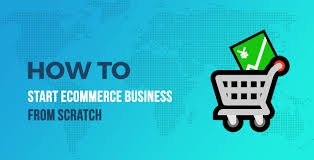Introduction
Starting a profitable ecommerce business in 2025 is an exciting yet challenging venture. With the rise of online shopping and global access, there has never been a better time to tap into the ecommerce market. However, with numerous competitors, it’s crucial to have a solid strategy, the right tools, and a clear understanding of how to set up and scale your online store. This guide will walk you through the key steps to launching a successful ecommerce business from scratch, ensuring you’re well-equipped for long-term profitability.
1. Identify a Profitable Niche (Days 1-7)
The first step in launching a successful ecommerce business is identifying a profitable niche. A niche market allows you to target a specific group of customers with tailored products, reducing competition and increasing your chances of success.
Key Steps to Identify Your Niche:
-
Research Market Demand: Use tools like Google Trends and Keyword Planner to find trending products or services with high demand but low competition.
-
Analyze Competitors: Study your competitors to identify market gaps or areas for improvement.
-
Solve a Problem: Focus on products that solve a specific problem or fulfill a need for your target audience.
Why It’s Important: A well-chosen niche helps you stand out and build a loyal customer base, making it easier to market and scale your business.
2. Choose the Right Ecommerce Platform (Days 8-14)
Selecting the right ecommerce platform is crucial for the success of your business. It determines how your store will look, function, and integrate with other tools.
Top Ecommerce Platforms in 2025:
-
Shopify: Known for its user-friendly interface, Shopify is ideal for beginners and businesses of all sizes. It offers customizable themes, secure payment options, and reliable customer support.
-
WooCommerce: A WordPress plugin, WooCommerce is perfect for those who are comfortable with WordPress. It’s flexible, cost-effective, and easy to integrate with a variety of plugins.
-
BigCommerce: Best for scaling businesses, BigCommerce offers advanced features like multi-channel selling and detailed analytics.
Why It’s Important: The right platform ensures a smooth user experience, helps you manage inventory and payments, and provides integration with third-party tools essential for your business.
3. Create a Unique Brand Identity (Days 15-21)
Your brand identity sets the tone for your business and plays a significant role in customer retention and trust. A memorable brand resonates with your target audience and distinguishes you from competitors.
Steps to Build Your Brand Identity:
-
Logo and Design: Create a professional logo and a consistent color palette for your website, packaging, and marketing materials.
-
Brand Voice: Develop a brand voice that reflects your business values. Decide whether you want your tone to be casual, formal, or friendly.
-
Storytelling: Share your story with customers to humanize your brand and create emotional connections.
Why It’s Important: A strong brand identity builds trust and loyalty with customers, increasing their likelihood of returning and recommending your store to others.
4. Source Your Products (Days 22-30)
Once you have a solid niche and brand, it’s time to source your products. Whether you’re manufacturing your own products, dropshipping, or working with a supplier, sourcing is crucial to ensuring quality and profitability.
Product Sourcing Methods:
-
Manufacturing: If you have the resources, manufacturing your own products offers high-profit margins and unique items for your customers.
-
Dropshipping: Dropshipping allows you to sell products without holding inventory, making it a low-risk option. Partner with suppliers who ship directly to customers.
-
Wholesale: Purchasing products in bulk from a supplier and selling them at a markup offers higher control over inventory and pricing.
Why It’s Important: The quality and reliability of your products directly impact customer satisfaction and repeat purchases, making this step crucial to long-term success.
5. Set Up Payment and Shipping Systems (Days 31-40)
Once your store is set up and stocked with products, the next step is to establish payment and shipping systems. These systems are vital for smooth transactions and ensuring your customers receive their products efficiently.
Steps to Set Up Payment and Shipping:
-
Payment Gateways: Choose a secure payment gateway like PayPal, Stripe, or Shopify Payments to process transactions safely.
-
Shipping Strategy: Decide on a shipping model—flat rate, free shipping, or tiered pricing. Partner with reliable couriers like FedEx or UPS, or consider using fulfillment services if dropshipping.
-
Tax Settings: Ensure your website is set up to automatically calculate taxes based on the customer’s location.
Why It’s Important: A seamless checkout and reliable shipping ensure a positive customer experience, reducing cart abandonment and increasing conversion rates.
6. Launch a Marketing Campaign (Days 41-60)
Now that your store is ready, it’s time to drive traffic to your website. Without a solid marketing strategy, even the best products will go unnoticed.
Effective Ecommerce Marketing Strategies:
-
Social Media Marketing: Leverage platforms like Instagram, Facebook, and TikTok to showcase your products, engage with customers, and drive traffic to your site.
-
Influencer Marketing: Partner with influencers in your niche to promote your products to their followers.
-
Email Marketing: Build an email list and send newsletters with promotions, new product launches, and exclusive offers.
-
SEO: Optimize your product descriptions, blog posts, and site structure for search engines to increase organic traffic.
Why It’s Important: A strong marketing campaign drives traffic, increases brand awareness, and boosts sales. It’s essential to create a marketing mix that reaches your target audience effectively.
7. Optimize and Scale (Days 61-90)
Once your business is up and running, the final step is optimization and scaling. At this point, you should focus on refining your processes, increasing sales, and expanding your reach.
Steps to Optimize and Scale:
-
Customer Feedback: Use customer feedback to identify areas for improvement and make adjustments to your products, website, or customer service.
-
Conversion Rate Optimization: Test different elements of your site (e.g., CTAs, product images, and page layouts) to improve conversion rates.
-
Expand Your Product Line: Add complementary products or variations to meet the evolving needs of your customers.
Why It’s Important: Scaling effectively requires continual optimization to enhance customer experience, improve sales, and reduce costs. Successful scaling ensures sustainable growth.
Conclusion
Starting a profitable ecommerce business from scratch in just 90 days is achievable with the right strategy, tools, and execution. By identifying a profitable niche, selecting the best ecommerce platform, building a strong brand, sourcing quality products, and launching targeted marketing campaigns, you can build a successful online business. Remember, the key to long-term success is continual optimization and scaling, so keep learning and adapting as your business grows.


